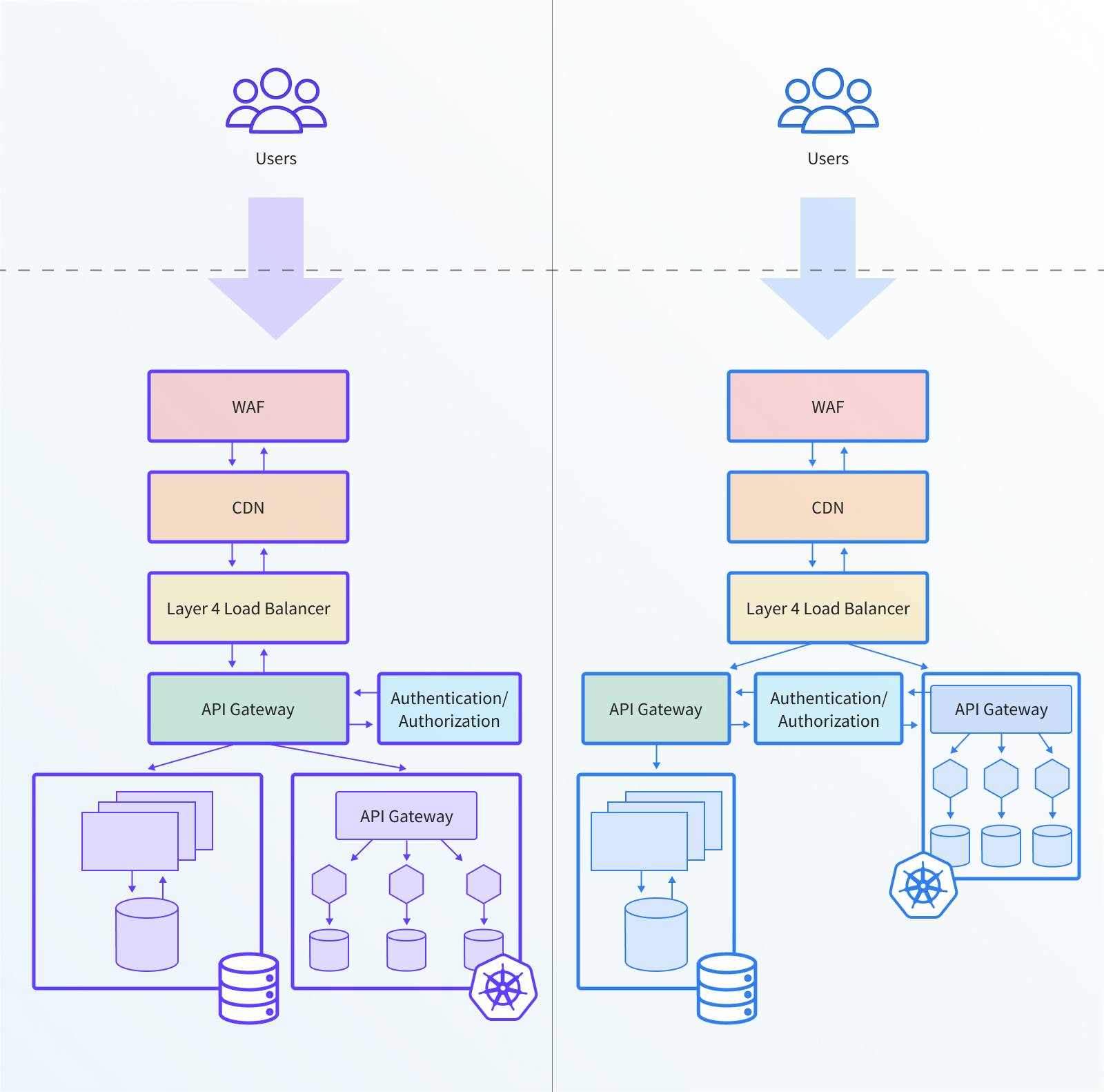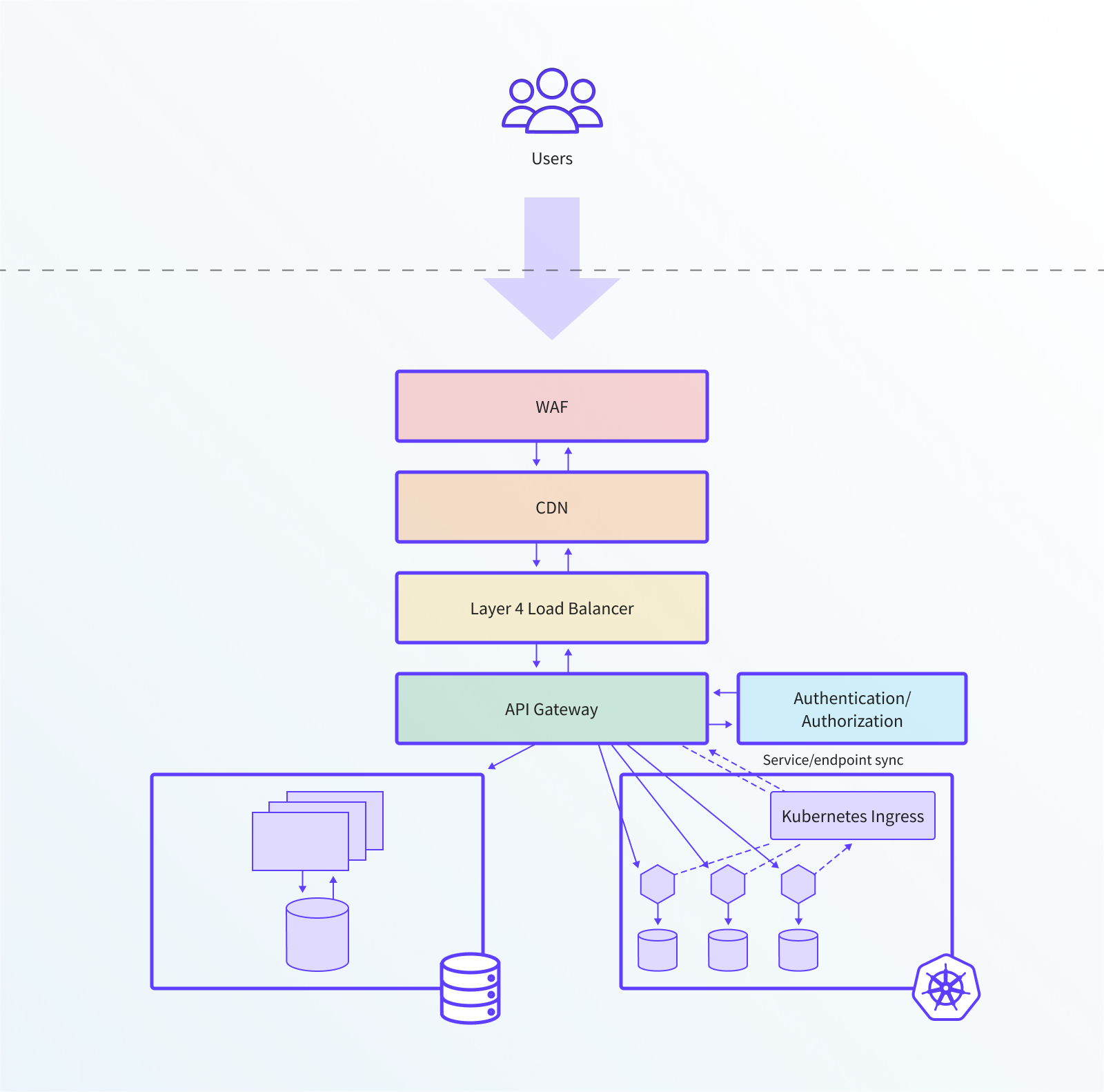3 Strategies for Managing APIs and the Edge with Kubernetes


Strategy #1: Deploy an Additional Kubernetes API Gateway
Strategy #2: Extend Existing API Gateway
Strategy #3: Deploy a Comprehensive Self-Service Edge Stack
Summary
Refactoring applications into a microservice-style architecture package within containers and deployed into Kubernetes brings several new challenges for the edge. In particular, as an increasing number of microservices are exposed to end users, the edge must support managing a multitude of configurations for a wide range of microservices. For more on these challenges, see the article “The Two Most Important Challenges with an API Gateway when Adopting Kubernetes.”
This article explores three strategies that engineering teams can apply in order to effectively manage the edge when migrating to microservices and Kubernetes: deploying an additional Kubernetes API gateway; extending an existing API gateway; and deploying a comprehensive self-service edge stack.

The presentation of each strategy includes a technical overview, a discussion of the associated pros and cons, and an analysis of how the solution can meet each of the two primary challenges with an API gateway when adopting Kubernetes.
Strategy #1: Deploy an Additional Kubernetes API Gateway
As suggested by the name, the implementation of this strategy simply consists of deploying an additional API gateway at the edge. Typically an organization with a web-based application that has existed for more than a few months will already have a series of components knitted together that provide edge and API management, such as a Layer 4 load balancer, Web Application Firewall (WAF), and traditional API gateway. With the “deploy an additional Kubernetes API gateway” strategy a platform team will simply deploy a completely separate gateway within the new Kubernetes clusters.
There are two variations for implementing this strategy. The first is to deploy the additional API gateway directly “below” the existing gateway. Here relevant traffic is forwarded from the existing gateway to the new and onto appropriate services. The second variation consists of deploying the new API gateway “alongside” the existing solution. With this approach, traffic is forwarded from an edge component higher up the stack, such as the layer 4 load balancer, to the new gateway, which in turn forwards the traffic to the Kubernetes services.
Once this strategy has been employed it can be operated and maintained using one of two approaches. Within some organisations, the existing platform or infrastructure team will be responsible for deploying and maintaining the new gateway. Other times, a completely separate team will own the new solution, or the responsibility will be pushed onto the individual microservice development teams. Regardless of the exact organisational structure, many of the routine changes that need to be made to the edge will need to be coordinated across the multiple API gateways and related components.
Architecture
The following diagram provides an architectural overview of the two typical implementations of the “deploy an additional API gateway” strategy. The left image shows the deployment of the new gateway “below” the current gateway, and the right image demonstrates the deployment of the new gateway “alongside” the existing solution:

Trade-offs
The following section highlights the key pros and cons with the “add an additional API gateway” strategy:
Pros
- There is minimal change to the core edge infrastructure. This strategy typically allows the use of all of the existing edge components.
- Incremental migration between VM-based and Kubernetes-based applications is easily supported by maintaining the two gateways concurrently.
- This approach provides a limited blast radius when catastrophic failures at the edge are encountered e.g. only the Kubernetes-based applications are affected if the new API gateway encounters an issue.
Cons
- There is an increased management overhead (and increased cognitive load) of working with different components, e.g., each API gateway will most likely have a different UI, SDK, or API.
- There is increased operational overhead with this approach, as an additional mission-critical API Gateway needs to be updated, maintained, and monitored.
- It can be challenging to expose the complete functionality of the edge components to each independent microservice teams (and difficult to support coordination). For example, if the existing API Gateway is used for authentication, microservice teams may not be able to directly configure this.
- It may potentially be difficult for all teams to understand the new architecture that is composed of multiple similar components. On a related theme, it may also be challenging to locate and debug where within the edge stack any issues occur.
Addressing Challenges
To scale edge management in this strategy, an organisation should implement a “multi-tier” edge management strategy:
- As much edge functionality as possible should be pushed into the Kubernetes API Gateway, and directly exposed to application developers. This maximizes agility and velocity within the development teams.
- For edge functionality that needs to remain centralized, the operations team should create a workflow for application developers, and support this with SLAs.
- Application development teams should use these SLAs in their release planning to minimize release delays.
- Properly chosen, the additional Kubernetes API Gateway can provide the breadth of functionality necessary to support a diverse range of microservices. This includes support for contemporary L7 protocols such as gRPC and gRPC-Web as well as observability and resilience features such as circuit breakers and automatic retries. Crucially, for newer protocols, existing edge components should be configured to pass-through traffic on specific routes to the additional gateway for proper functionality. Note that there is a tradeoff in this approach, as for these routes the rest of the existing edge stack cannot be used.
Strategy #2: Extend Existing API Gateway
The “extend existing API gateway” strategy is implemented by modifying or augmenting the existing API gateway solution that is currently deployed in production. The key goal with this modification is to enable synchronization between the API endpoints that a user accesses and the location of the corresponding services deployed within the new Kubernetes clusters.
In Kubernetes, this is typically done by deploying a custom ingress controller for the existing API Gateway or load balancer. The ingress controller will parse Kubernetes ingress configurations, translate the ingress configuration into the native API Gateway format, and configure the API Gateway or load balancer via their respective APIs.
Architecture
The following diagram provides an architectural overview of the typical implementation of the “extend existing API gateway” strategy. In this diagram, the ingress controller is deployed on a standalone pod in the cluster, reading Kubernetes ingress configuration. The configuration is then passed to the existing API Gateway / load balancer, which is deployed outside of the cluster.

Trade-offs
The following section highlights the key pros and cons with the “extend existing API gateway” strategy:
Pros
- This strategy provides the ability to use the existing API gateway; this technology is tried and tested, and the platform team have familiarity with this.
- The platform team can leverage existing integrations with on-premises infrastructure and services e.g. hardware load balancers routing to a new on-premises k8s cluster.
- There is minimal need to learn Kubernetes networking technologies, especially for the development teams who will not interact with the edge or cluster ingress.
Cons
- Existing configuration workflows will need to change in order to preserve a single source of truth for the API gateway configuration.
- Most custom ingress controllers expose a limited amount of configuration parameters via Kubernetes annotations, and require cumbersome ConfigMaps or other workarounds to configure more advanced options.
- Additional education and training may be required to educate developers, especially configuration parameters that are not native to the ingress controller.
Addressing Challenges
To scale edge management using this API gateway extension strategy, an organisation should fully embrace the recommended configuration approach as specified by the Kubernetes ingress controller, and shift away from the traditional API/UI-driven configuration model of their existing gateway. In addition, a standardized set of scripts should be used so any modification of routes to services running outside the Kubernetes cluster does not conflict with the services running inside the new cluster
Before adopting the strategy, an architectural roadmap review of current and anticipated edge requirements for microservices is essential. Ensuring the existing gateway / load balancer supports these requirements will avoid a situation where adding another API gateway is required to support an unexpected requirement.
Strategy #3: Deploy a Comprehensive Self-Service Edge Stack
Deploying a self-service edge stack consists of using a Kubernetes-native API gateway that contains additional integrated supporting edge components such asWAF and authentication/authorization. The edge stack is installed in each of the new Kubernetes clusters, and replaces and consolidates the majority of existing edge and gateway functionality that previously ran outside the cluster.
Once this strategy is deployed, it is common to see the platform team responsible for the underlying infrastructure components (and their successful operation and monitoring) and also providing “sensible defaults” for managing cross-functional requirements, such as default timeout values, retries, and circuit breaking. The independent microservice teams are then fully empowered and responsible for configuring the edge stack as part of their normal workflow; for example, when a new service is deployed, the development team will also specify the routing configuration and override the existing cross-functional defaults.
Architecture
The following diagram provides an architectural overview of the two typical implementations of the “deploy a comprehensive self-service edge stack” strategy.

Trade-offs
The following section highlights the key pros and cons with the “deploy a comprehensive self-service edge stack” strategy:
Pros
- This strategy provides good integration with the new API gateway and the surrounding “cloud native” stack, such as Kubernetes, service meshes, and online identity (IdP) brokers.
- Edge management is simplified into a single stack that is configured and deployed via the same mechanisms as any other Kubernetes configuration. This can enable independent microservice teams to “self-serve” all of their configuration changes.
- This approach allows the engineering team to embrace cloud native best practices, such as defining a “single source of truth” for edge configuration, supporting dynamic/elastic infrastructure, and aiding rapid config changes (via approaches like GitOps).
Cons
- There is potentially a large architectural shift. Existing edge components will be replaced, and existing network architectures and configuration may need to change.
- This strategy will require the platform team learn about new proxy technologies and potentially new edge component technologies.
- There will be changes to engineering workflow. For example, along with the ability for independent microservice teams to configure the edge to support a wide range of protocols and architectures, comes increased responsibility, both at design-time and during operation..
Addressing Challenges
In the self-service edge stack strategy, each microservice team is empowered to maintain the edge configuration specific to each of their microservices. The edge stack aggregates the distributed configuration into a single consistent configuration for the edge. To support the diversity of the edge services, adopt an edge stack that has been built on a modern L7 proxy with a strong community such as the Cloud Native Computing Foundation’s Envoy Proxy. The breadth of the community helps ensure that the core routing engine in the edge stack will be able to support a diversity of use cases.
Summary
There are three primary strategies for managing APIs and the edge of a system when migrating to a microservices-based architecture deployed into new Kubernetes clusters. This article has provided an overview of the three approaches: deploying an additional API gateway; extending an existing API gateway; and deploying a self-service edge stack.